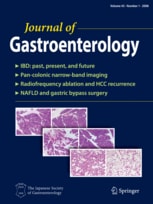Real-time tissue elastography as a tool for the noninvasive assessment of liver stiffness in patients with chronic hepatitis C
患者さんの体に針を刺して肝生検させて頂くなくても肝臓の硬さが予想できそうだとする、日本製の超音波診断検査の有用性を外国製の機械と比較して報告した論文です。
私が長年、期待していた内容です。更に発展いたしますように。
Volume 46, Number 3, 350-358, DOI: 10.1007/s00535-010-0301-x
ORIGINAL ARTICLE—LIVER, PANCREAS, AND BILIARY TRACT Real-time tissue elastography as a tool for the noninvasive assessment of liver stiffness in patients with chronic hepatitis C Hiroyasu Morikawa, Katsuhiko Fukuda, Sawako Kobayashi, Hideki Fujii, Shuji Iwai, Masaru Enomoto,Akihiro Tamori, Hiroki Sakaguchi and Norifumi Kawada
Abstract
Background
Although histopathological examination by “invasive” liver biopsy remains the gold standard for evaluating disease progression in chronic liver disease, noninvasive tools have appeared and have led to great progress in diagnosing the stage of hepatic fibrosis. The aim of this study was to assess the value of real-time tissue elastography, using an instrument made in Japan, for the visible measurement of liver elasticity; in particular, comparing the results with those of transient elastography (Fibroscan).
Methods
Real-time tissue elastography (RTE), transient elastography (Fibroscan), liver biopsy, and routine laboratory analyses were performed in 101 patients with chronic hepatitis C. The values for tissue elasticity obtained using novel software (Elasto_ver 1.5.1) connected to RTE were transferred to four image features, Mean, Standard Deviation (SD), Area, and Complexity. Their association with the stage of fibrosis at biopsy and with liver stiffness (kPa) obtained by Fibroscan was analyzed.
Results
Colored images obtained by RTE were classified into diffuse soft, intermediate, and patchy hard patterns and the calculated elasticity differed significantly between patients according to and correlated with the stages of fibrosis (p < 0.0001). Mean, SD, Area, and Complexity showed significant differences between the stages of fibrosis (Tukey–Kramer test, p < 0.05). In discriminating patients with cirrhosis, the areas under the receiver operating characteristic curves (AUC) were 0.91 for Mean, 0.84 for SD, 0.91 for Area, 0.93 for Complexity, and 0.95 for Fibroscan.
Conclusions
RTE is a noninvasive instrument for the colored visualization of liver elasticity in patients with chronic liver disease.


ディスカッション
コメント一覧
まだ、コメントがありません